Archived Blog Posts
Mold Revealed: Where Does Mold Grow and How to Prevent It
5/23/2023 (Permalink)
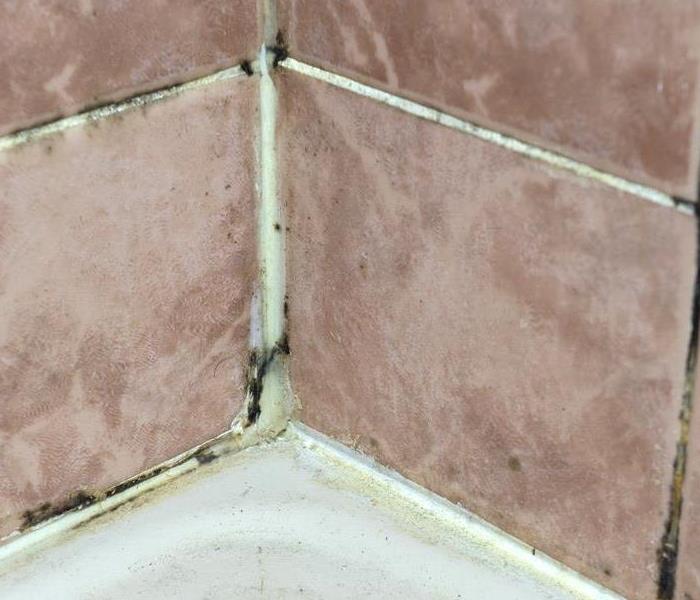 Mold can grow in your home or workplace, call a professional mold remediation company for proper cleanup.
Mold can grow in your home or workplace, call a professional mold remediation company for proper cleanup.
Mold, a type of fungi, can grow in various places both indoors and outdoors. It thrives in environments that are damp, warm, and have organic matter to feed on. Understanding where mold grows is essential in order to prevent its growth and keep our homes and workplaces healthy.
Bathrooms
Bathrooms are notorious for mold growth due to the high levels of moisture generated by daily activities such as showering, bathing, and washing. Mold can often be found on walls, ceilings, around tubs, showers, and sinks, and even on shower curtains. It can also grow in hidden areas such as behind bathroom tiles or under bathroom cabinets.
To prevent mold growth in bathrooms, it's important to ensure proper ventilation by using exhaust fans or opening windows to allow for air circulation. Regularly clean and dry bathroom surfaces, including tiles, grout, and shower curtains. Fix any leaks or water damage immediately and keep humidity levels in check by using a dehumidifier if necessary.
Kitchens
Kitchens are another common area where mold can grow due to the presence of moisture from cooking, washing dishes, and using appliances like dishwashers. Mold can be found on walls, under sinks, in and around refrigerators, and even in forgotten food containers.
To prevent mold growth in kitchens, wipe down countertops, sinks, and appliances regularly to keep them dry. Fix any leaks in plumbing or appliances promptly. Store food properly and avoid leaving dirty dishes in the sink for extended periods of time. Proper ventilation in the kitchen can also help to reduce humidity levels and prevent mold growth.
Basements
Basements are often dark, damp, and poorly ventilated, making them prime breeding grounds for mold. Mold can grow on walls, floors, and ceilings in basements, especially if there is a history of water intrusion or flooding.
To prevent mold growth in basements, ensure proper drainage and address any water leaks or flooding immediately. Use dehumidifiers and fans to improve ventilation and reduce humidity levels. Insulate walls to prevent condensation and promote proper air circulation. Regularly check for signs of mold growth and address them promptly.
Attics
Attics can also be prone to mold growth, especially if there is inadequate insulation or ventilation. Mold can grow on attic walls, ceilings, and rafters, particularly in areas where moisture accumulates.
To prevent mold growth in attics, ensure proper insulation and ventilation. Inspect the attic regularly for any signs of moisture, such as water stains or condensation, and address them promptly. Keep the attic well-ventilated to allow for proper air circulation and reduce humidity levels.
Crawl spaces
Crawl spaces, if not properly ventilated or if there is water intrusion, can become breeding grounds for mold. Mold can grow on walls, floors, and insulation in crawl spaces, and can easily spread to other areas of the home.
To prevent mold growth in crawl spaces, ensure proper ventilation by installing vents or fans. Address any water intrusion or leaks immediately and install a moisture barrier on the floor to prevent moisture from seeping into the crawl space. Inspect the crawl space regularly for any signs of mold growth, such as musty odors or visible mold, and take prompt action to remediate it.
In conclusion, mold can grow in various areas both indoors and outdoors where there is moisture, warmth, and organic matter to feed on. Preventing mold growth requires proper ventilation, regular cleaning and maintenance, prompt repair of leaks or water damage, and keeping humidity levels in check. Regular inspections for signs of mold growth and taking prompt action for remediation are also crucial. By being vigilant and proactive, we can prevent mold growth and keep our homes and workplaces healthy and safe.
If you suspect a mold problem in your home or workplace, it's best to consult with a professional mold remediation service for proper assessment and remediation.
Fire Sprinkler Systems: How They Work and Why You Need Them
4/29/2023 (Permalink)
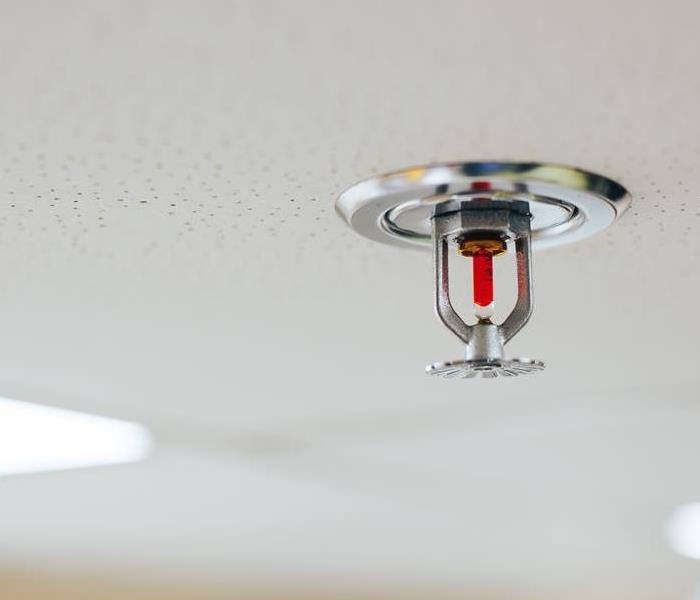 Fire sprinkler heads are an important part of building fire protection.
Fire sprinkler heads are an important part of building fire protection.
A fire sprinkler system is an automated system that detects and suppresses fires. It uses water to extinguish flames, prevent the spread of fire, and protect people and property from damage.
Components of a Fire Sprinkler System
The water supply for a sprinkler system needs to be able to provide enough pressure so that it can reach all areas of your home or business before running out during an emergency situation. The water supply can come from either municipal sources or private well, however, if you live in an area where there are earthquakes or floods then you should consider having two separate sources for backup purposes.
If possible try not using PVC pipes because they tend not to last as long as other materials such as copper or steel due to corrosion issues over time which could cause leaks within your pipes causing damage inside your walls/ceilings etc.
How Does a Fire Sprinkler System Work?
A fire sprinkler system is made up of a network of pipes and valves that are connected to the building's water supply. The pipes are connected to the sprinkler heads, which are installed in various locations throughout your home or business. When a fire breaks out, heat from the flames activates a device inside each sprinkler head called an electric solenoid valve (ESV). This causes water from nearby pipes to flow through small openings in their bodies into an expansion chamber within them and then out onto floors, walls and other surfaces where it cools down hot spots caused by flames.
Sprinklers can be activated by either heat or smoke detectors; however most systems use both technologies together as part of what's called "dual detection." If there's no smoke present but only heat from an electrical short circuit or other source causing damage to wiring insulation near one location within your structure then this may trigger activation too!
Types of Fire Sprinkler Systems
Wet pipe systems - These are the most common type of sprinkler system and use water from a municipal water supply or private well. The water is stored in an underground tank, which can be located either inside or outside your home. When there's a fire, this type of system uses gravity to distribute water through pipes that run throughout your home.
Dry pipe systems - These also use municipal or well water but have no storage tank; instead, they rely on pressurized air pressure to keep water flowing through pipes after they've been activated by heat sensors or manual activation switches (usually installed by firefighters). They're best suited for areas where frequent fires are unlikely because they don't have much capacity for storing excess amounts of liquid when there isn't one happening--and if there is one happening, it might take too long for firefighters to get there before everything burns down anyway!
Fire sprinkler systems are an important part of a building's fire protection plan, and they can help to protect you and your property from the devastating effects of a fire.
The Importance of Regular Pipe Inspections: Protecting Your Home or Business from Plumbing Disasters
3/11/2023 (Permalink)
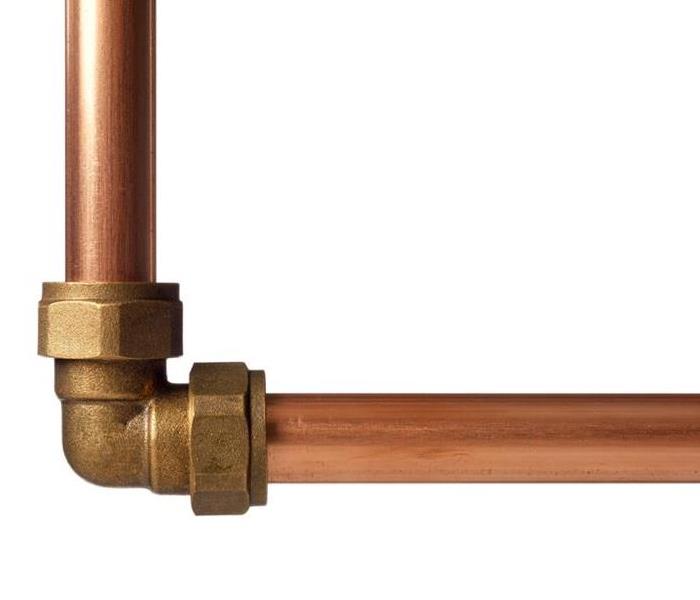 Regular pipe inspections are good for protecting your home from future pipe breaks.
Regular pipe inspections are good for protecting your home from future pipe breaks.
Regular pipe inspections are essential for maintaining the health and safety of your home or business. Pipes are an integral part of any building's plumbing system, and any issues with them can cause significant damage to your property, resulting in expensive repairs and even potential secondary damages. In this blog post, we will discuss why regular pipe inspections are crucial for both homes and businesses.
Prevention of Blockages
One of the primary reasons why regular pipe inspections are essential is to prevent blockages. Over time, pipes can become clogged with hair, grease, food particles, and other debris. These blockages can restrict the flow of water, leading to slow drainage, and even complete blockages. Regular inspections can detect these blockages early and allow for their removal before they cause any significant damage.
Avoiding Water Damage
Leaks and burst pipes can cause significant water damage to your property, leading to costly repairs and even health hazards such as mold growth. Regular inspections can identify any leaks or potential weaknesses in the pipes before they cause water damage. In addition, inspections can detect any corrosion or rusting of pipes, which can weaken them and lead to burst pipes.
Maintaining Water Quality
Another critical reason why regular pipe inspections are important is to maintain water quality. Over time, pipes can become corroded, leading to the release of harmful chemicals into the water supply. Regular inspections can detect any corrosion or damage to pipes and allow for the replacement of any affected pipes, ensuring that the water supply remains safe and healthy for consumption.
Cost Savings
Regular pipe inspections can save you money in the long run by preventing major repairs and water damage. Early detection of potential problems can allow for timely repairs, preventing any further damage to your property. Additionally, regular maintenance of pipes can extend their lifespan, reducing the need for expensive replacements.
Compliance with Regulations
In addition to the above benefits, regular pipe inspections are often required by law to comply with building and safety regulations. For example, businesses in the food industry are required to have regular inspections to maintain food safety standards.
In conclusion, regular pipe inspections are essential for maintaining the health and safety of your home or business. They can prevent blockages, avoid water damage, maintain water quality, save money, and ensure compliance with regulations. Don't wait for a plumbing emergency to occur; schedule regular pipe inspections to ensure the proper functioning of your plumbing system and avoid costly repairs.
Protect Your Home During a Flood
2/11/2023 (Permalink)
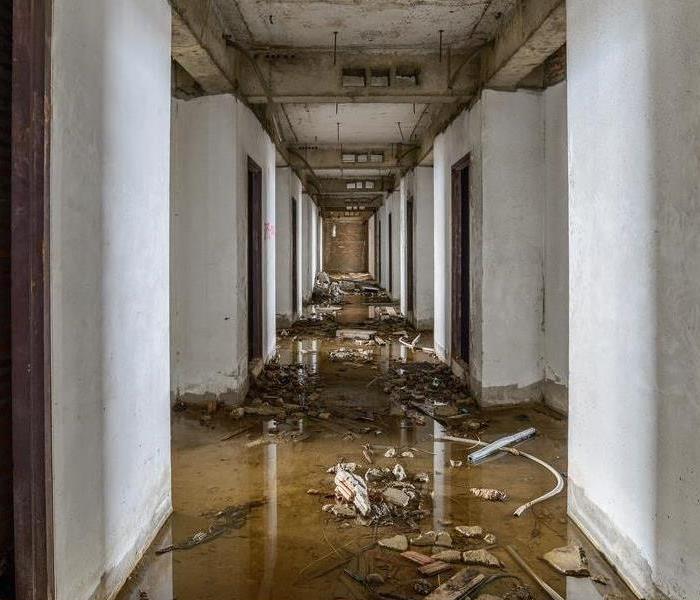 When flood water damage occurs in your home or business, give SERVPRO of Providence a call today!
When flood water damage occurs in your home or business, give SERVPRO of Providence a call today!
You might think of your home as a safe haven, but it can also be a liability. If you live in an area that's prone to flooding, you may want to make sure your property is protected against water damage. Ensuring that the exterior of your home is sealed and proper drainage for heavy rainfall is crucial to saving your home from flood damage.
Seal your foundation.
Seal any cracks in your foundation. This will keep large amount of rainfall from seeping through into your crawlspace causing water damage under your home. Seal cracks in basement walls, garage walls, and floors to keep the water away from potential personal belongings. Last repair any leaks from plumbing or appliances that you may have already seen potential for flood and water damage.
Maintain drainage areas.
The drainage areas around your home should be kept clear of debris and maintained. A good rule of thumb is that any drainage area that is less than 6 feet wide should be sloped away from the house, with a grade of at least 1/4 inch per foot. If there is not enough room for this slope, then fill it with gravel to prevent water from pooling in low spots and causing damage to foundations or flooring inside the house.
Gravel can also help absorb some of the shock waves caused by lightning strikes on metal roofs. It's important to clean out these areas regularly so they don't become clogged up with leaves and other debris that could cause flooding if left unattended over time.
Install a sump pump.
A sump pump is a great way to keep your home safe from flooding. These devices can be installed in basements or other areas of the home, and they can be installed by a professional or DIY. Sump pumps need to be maintained regularly so that they work when needed most, but if you want to install one yourself, here's what you need:
- A sump basin (the container where water collects)
- A check valve (prevents backflow)
- An overflow pipe with a float switch attached
- A submersible pump
Water is fast! Water can cause structural damage, as well as interior damage. In some cases where there has been severe flooding in homes it's because they didn't have any kind of backup system installed, these alarms alert you when there is a large amount of water fall helping you to escape from your home or property before you can't.
Remember that prevention is always the best option, so if anything seems suspicious in your neighborhood (like standing water), report it immediately! Give SERVPRO of Providence a call at the first sign of water damage from flood waters in your home or business.
4 Types of Storm Damage
1/20/2023 (Permalink)
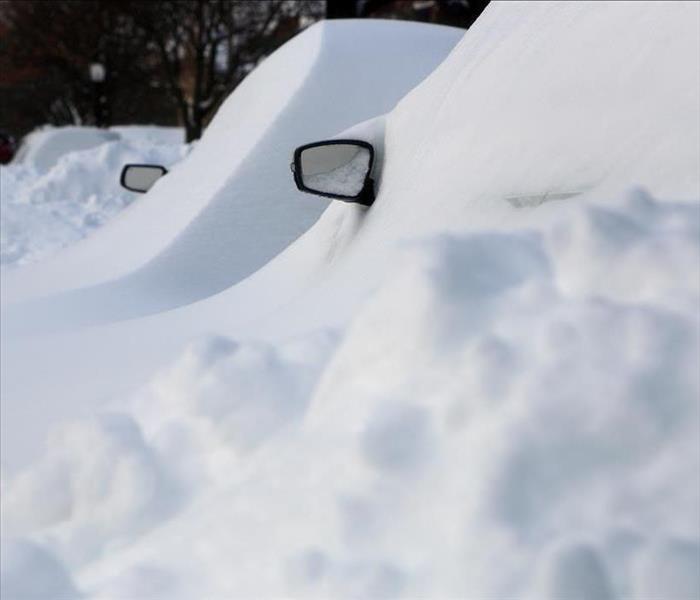 A storm can cause significant damage to a home, both inside and outside.
A storm can cause significant damage to a home, both inside and outside.
A storm can cause significant damage to a home, both inside and outside. A storm can tear down trees, break windows, and cause water damage from flooding. It might also blow away a portion of your roof or siding. This can be very dangerous since it exposes your home to the elements. To make sure that you’re prepared for any kind of storm damage or debris removal service after a storm hits your area, we are going to discuss some possible storm damage you could experience at your Providence home or business.
Snowstorm Damage
A snowstorm can cause damage to homes and cars. If a roof is damaged, you may need to replace it, which can be expensive. Gutter and downspout systems wear out over time and may need to be replaced if they're damaged during a storm. The same is true of siding, windows, and doors; these are all important parts of your home's exterior as well as its interior integrity. Finally, snow accumulation on decks or porches can lead to structural failure if the weight becomes too great for them to support themselves properly anymore.
Lightning Damage
Lightning strikes can cause a variety of damage. Lightning-related fires are the most common type of storm damage. If lightning strikes your roof or any other part of your home, the electrical current can burn through wiring and ignite insulation. It's important to have a professional assess your roof after a storm; if there is any sign of fire or smoke damage, they will be able to find ways to repair it quickly before the damage spreads further.
Hail Damage
Hail damage can be a costly inconvenience, but it’s also quite common. This type of weather is typically accompanied by thunderstorms that bring lightning and heavy rain. Hailstones are small ice balls that fall from the sky in a storm cloud when the pressure in the clouds gets low enough for water droplets to freeze.
Hail can cause roof damage and broken windows as well as cracked exterior walls if it hit hard enough to break through glass or siding material. If your home has been damaged by hail, you may have to replace shingles on your roof or other materials depending on what was damaged or destroyed during such an event.
Tornado Damage
A tornado is a violently rotating column of air that extends from the base of a thunderstorm to the ground. The strong winds caused by a tornado can cause severe damage, including roof damage and broken windows. A tornado can also cause structural damage, flooding and water damage, fire damage, mold damage, or even loss of life.
If you have been affected by any of these types of storm damage — or any other kind — it's important that you make sure your home has been properly inspected by an experienced contractor before you bring anyone back into the house after repairs are complete.
Hire a Professional
We recommend hiring a professional restoration company like SERVPRO of Providence if you need repairs after a storm. We will make sure to assess the damage thoroughly, come up with a reasonable plan, and get you back to normal as quickly as possible. No matter what kind of damage you have, it’s important to seek out professional help so that your house or business can be restored quickly and properly.
Different Types of Hoarding Explained
12/12/2022 (Permalink)
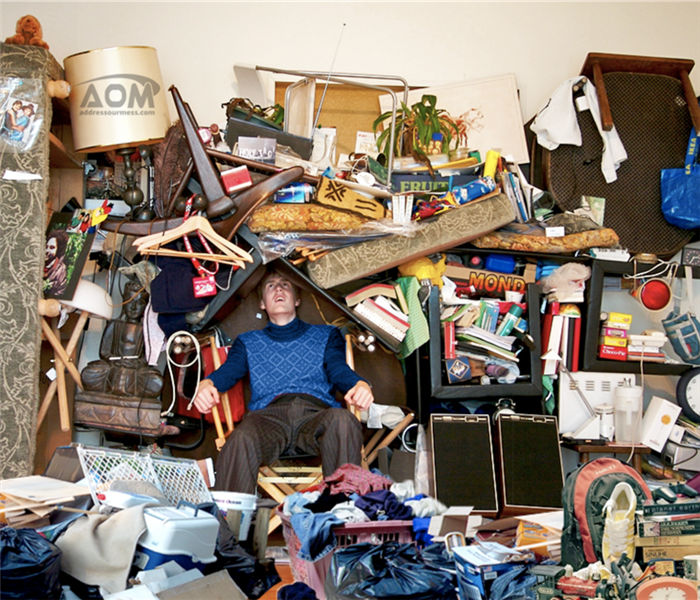 Hoarding cleanup and restoration services are a relatively new industry.
Hoarding cleanup and restoration services are a relatively new industry.
Risks of Hoarding
Hoarding is a mental health condition that affects 2% to 5% of people in the United States. It's characterized by a persistent inability to get rid of possessions due to a perceived need to save them. Over time, this can lead to dangerous situations and cause emotional stress on both the hoarder and those around them. There are several different types of hoarding, each with its own unique characteristics.
What is Hoarding?
Hoarding is a mental disorder that causes people to accumulate items in their homes to the point where it becomes dangerous to their health and well-being. Hoarding occurs when a person experiences severe distress at the thought of getting rid of any item, regardless of its value. This can lead to extreme clutter and many hazards associated with living in an unsafe environment.
Why do people hoard?
There are many reasons why someone may hoard, but the most common causes include:
- post-traumatic stress disorder (PTSD)
- depression
- anxiety disorders
- obsessive compulsive disorder (OCD)
Risks of Hoarding
There are many ways that clutter can cause an unsafe environment. Clutter has been shown to increase the risk of falls and other types of accidents, and hoarding can also be linked to malnutrition, health care problems, and even fires.
This can cause problems with sanitation, food storage, and fire hazards. But the danger doesn't stop there. Hoarding also makes it hard for a person to keep their home clean and safe, which can lead to serious problems for both them and those around them. When you live in a cluttered space, you're more likely to get injured by tripping over things or having your belongings fall on top of you. The mess also creates an environment where mold can grow, or animals can live, which could lead to rodent infestation. It also makes it easier for fires to break out and quickly spread throughout the space.
Hoarding Cleanup and Restoration Services
Hoarding cleanup and restoration services are a relatively new industry. These companies specialize in helping people who are dealing with hoarding issues, by removing the items from their home, cleaning up the space and restoring it to its original state.
Some of the services provided by these companies include:
- Removal of trash, debris and other excess items
- Deodorizing or sanitizing the area
- Hauling away unwanted materials to be recycled or disposed of properly
- Packing up valuables for storage (if required)
Don't be ashamed to live in a cluttered home.
If you live in a cluttered home that makes you feel ashamed, don't be! There are many companies and professionals out there who can help. Companies such as SERVPRO of Providence can help you safely remove debris, deodorize and sanitize the area, and dispose of unwanted materials safely so that you can return to a clean and safe home.
Conclusion
Hoarding is a complex mental health condition that can be difficult to deal with. However, it's important to know that there are options out there for people suffering from this disorder. If you or someone you know has been struggling with hoarding or another type of OCD, contact us today! We have the professional resources needed to help get your home cleaned up.
How Do I Install a New Toilet?
11/9/2022 (Permalink)
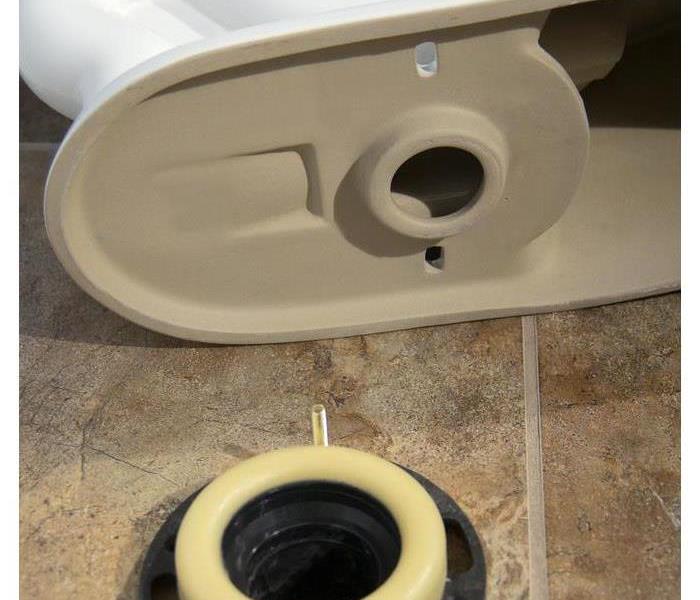 It's time to install your new toilet.
It's time to install your new toilet.
Installing a New Toilet
Don't be afraid of the toilet. It's an essential part of your home, and it doesn't have to be complicated. In fact, installing a new one is easy — as long as you're careful and follow these steps.
Turn off the water supply
The first step to installing a new toilet is to turn off the water supply. If you don't know where your water shutoff valve is, this is a good reason to call a plumber or handyman with experience. The process of turning off the water supply involves shutting off pipes that are running through your walls, so it's not something you want to mess up if you're unfamiliar with plumbing.
Disconnect the water supply line
This can be done by shutting off the main valve or turning off individual shut-off valves for each fixture.
Next, remove the supply line from the valve using a wrench and disconnect it from your toilet by removing 2 screws as needed on either side of where it connects at its base (most toilets will have 4 screws). Make sure you have something handy such as a bucket or large bowl to catch any water that may leak out during this process!
Drain the tank and bowl by holding down the handle and flushing
Now that you've done all the prep work, it's time to install your new toilet. First, drain the tank and bowl by holding down the handle and flushing. Use a bucket to catch water as it drains into the bowl, so you don't have to mop up a mess. If you're still having issues with leaking after doing this step once or twice, try re-tightening any bolts/screws that were loose before as well as re-adding additional washers if needed.
Remove old toilet
If there is a wax ring, remove it by prying it up with a screwdriver. Then use a putty knife to scrape away any remaining wax from around the base of your new toilet. If your toilet has been glued to the floor, use a pry bar to lift it up and off its flange.
- Unbolt or remove bolts on bottom portion of tank and set aside for re-use if possible (if not, don't worry about removing them now)
- Unbolt or remove bolts on top portion of tank using ratchet wrench and socket
Inspect and clean the closet flange
The closet flange is a metal ring that fits in the drainpipe, allowing you to mount the new toilet on top of it. The closet flange should be accessible from below where you plan to install your new toilet. You can do this by lifting on the wax ring on top of your existing toilet or by removing it entirely if it's not too firmly stuck down (if so, use a flathead screwdriver).
Once you take off that section of wax ring, look at what's underneath: You're looking for damage or corrosion around any seams between different pieces of metal—this can mean that part won't seal properly or could cause leaks. If there's visible corrosion or dents, replace that piece before proceeding with installation.
Install new wax ring and toilet
The wax ring is what seals the toilet to the floor. If you are replacing an old toilet, you need to buy a new wax ring and install it before installing your new toilet.
You can buy wax rings at any hardware store.
Toilet Installation
Toilet installation isn't rocket science, but it's not simple either. Follow these steps to do it right!
1. Ask for help. If you're installing a new toilet in your Providence, RI home, your best option is to ask a friend or family member who knows how to install toilets well. They can give you advice on what tools and materials to use, how much time the project will take, and whether they'll be able to help with any of the work itself (or if they'd like payment up front).
2. Don't try to do everything yourself. You may have seen videos on YouTube where people install their own toilets without any assistance - but don't take this as an example of something that can be easily done by most people!
3. Take your time: Follow all instructions carefully so that everything goes smoothly.
Even if you've never installed a toilet before, we hope this guide has shown you that it's not too hard of a job. Just be sure to follow these steps and you'll be done in no time!
How Do I Know If My Fire Sprinklers Are Ready?
10/7/2022 (Permalink)
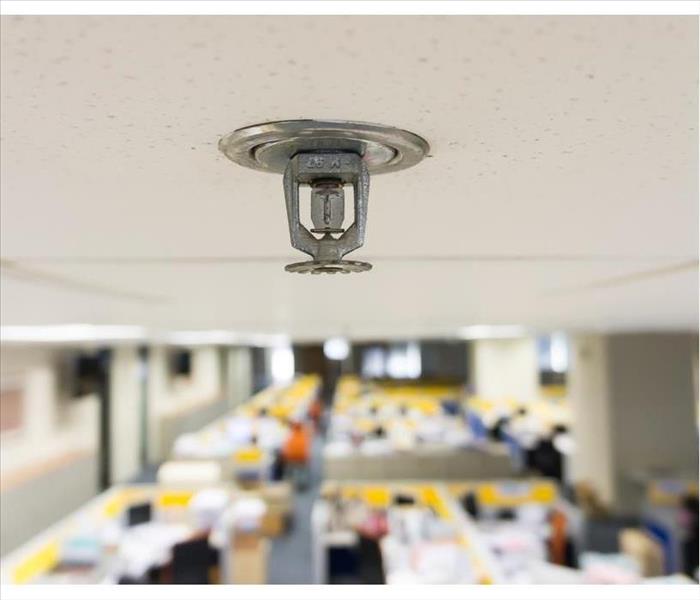 Fire sprinklers are a great way to protect your business.
Fire sprinklers are a great way to protect your business.
What Are the Signs That My Fire Sprinklers Are Prepared?
Fire protection can be a critical part of your business and knowing how to keep your fire sprinkler system in top condition is important. Here are some tips for maintaining your sprinklers so that you can ensure that they're ready when you need them most.
About The Sprinkler System
Fire sprinklers are installed in buildings of all types and sizes. A fire sprinkler system is a network of pipes, valves and sprinkler heads connected to an alarm system that automatically detects the presence of smoke in a building. The detection initiates an automatic discharge from one or more pre-determined sprinklers, which releases water over a wide area to suppress the spread of fire while alerting occupants of the building.
Sprinkler maintenance is critical for ensuring that your automatic system operates properly and efficiently. A semi-annual inspection by a licensed professional can help you identify any issues before they become serious problems that could put people at risk.
Cleaning Your Sprinklers
How do you know when to clean your sprinklers?
You should clean them whenever they are dirty. This will ensure that they will be in good working order and able to put out water as soon as a fire starts. If you have an annual inspection from the fire department, the inspector may tell you when it is time for your sprinklers to be cleaned. You can also talk with an expert about this or look at maintenance schedules online if none of these options work for you.
What materials should I use to clean my sprinkler heads?
You will want a non-acidic cleaner that does not contain ammonia, bleach, or sodium hydroxide (also known as lye). These chemicals can damage the metal parts inside of your sprinklers. What do I do once I have my supplies ready?
When cleaning your sprinklers, make sure that all electrical power has been shut off before beginning any work on them! Next: lay down protective sheets like cardboard underneath each head so that no moisture can seep into anything else (and potentially start another fire!) Afterward: use small brushes or toothbrushes where needed; spray cleaners onto brush heads then scrub gently away dirt/grease buildup within assembly holes/pipe openings/etc.; rinse thoroughly after each part has been cleaned thoroughly enough so all traces of dirt are gone from inside components; finally dry everything well with paper towels then replace plastic covers back onto heads again after drying – you don't want mold growth happening inside there too!
Water Shut Off Valve
If your building has a water shut off valve, this is an excellent way to know if your fire sprinklers are ready.
- Find the valve in the building. It should be near an exit door or a stairwell, and it will look like a small faucet that's not connected to anything else. You may need to ask someone for help locating it.
- Shut off the water to your building by turning on the valve so that no water flows out of it at all.
The Maintenance Schedule for Your Sprinkler System
It is important to know the maintenance schedule for your sprinkler system. If you do not know the maintenance schedule, ask your fire protection professional.
If you are unsure of the maintenance schedule, contact a fire protection professional who can provide you with information specific to your system and location.
Keep an eye on your fire protection and emergency systems to help you keep your business up and running smoothly.
It is important to know when your sprinkler system needs maintenance, especially if you are not familiar with it. If a professional isn't readily available, check for leaks in the piping, damaged or blocked heads and/or nozzles, as well as signs of rust or corrosion.
Fire sprinklers are a great way to protect your business, but they’re not always easy to maintain. That’s why we recommend hiring a professional fire protection company like us at Master Protection Services for all your fire protection needs. We can make sure your system is working properly and ready to use in any emergency.
Ways To Keep Your Property Safe From Secondary Damage
8/30/2022 (Permalink)
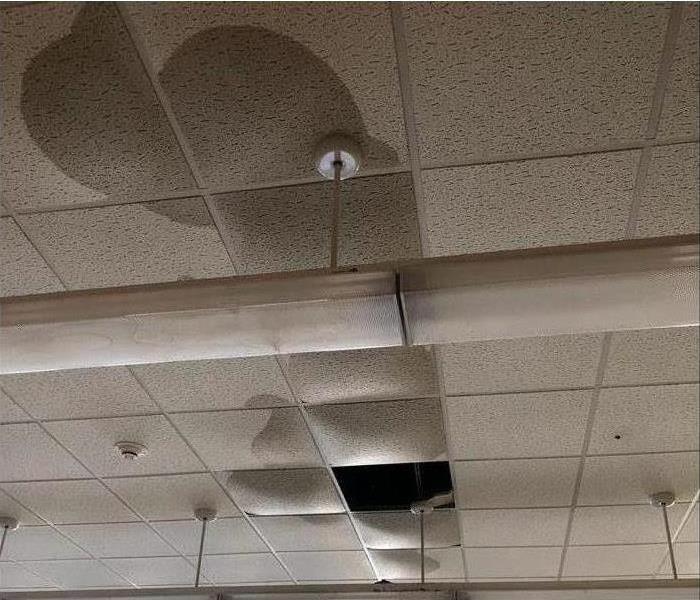 Water has ruined the ceiling tiles in this commercial building.
Water has ruined the ceiling tiles in this commercial building.
Ways To Keep Your Property Safe From Secondary Damage
Every year in Providence, RI, hundreds of business claims are filed as a result of water damage. Sometimes accidents are unavoidable; the damage might be the result of a flood, a pipe break, or a broken water heater.
These claims can be extremely costly, sometimes totaling ten thousand dollars or more, which could cause insurance rates to go up. And depending on what type you have, your policy might not cover certain things like secondary damage from mold.
Luckily, you can take steps to prevent or drastically reduce the amount of damage your building could sustain and save yourself from having to file a business claim. Here are a few things you can do to help keep your property safe from harm:
1. Leak Sealing
Make sure to inspect your foundation and areas around the exterior. If you find a crack or gap, make it watertight with the appropriate sealant.
2. Pipe Insulation
Any pipes that are exposed or accessible should be completely covered by insulation. If a pipe becomes frozen, it's easy for it to expand and burst. You should be able to find insulating materials at your local hardware store.
3. Drainage
It's important that water is able to drain away from the structure. Any gutters or downspouts should be kept clear of leaves or any other potential blockage, and the drainage areas should be free of debris.
4. Asset Protection
You should make sure that any valuable assets, such as electrical equipment and appliances, are raised above the floor to keep them safe from flooding. Non-waterproof valuables, such as important papers, should be stored in a secure place.
5. Consultation
It may be a good idea to consult with a professional water mitigation company about damage prevention. They can do a thorough inspection to make sure you haven't missed anything, and then give you expert, customized advice.
Filing a business claim for water damage is a hassle no one wants to have to deal with. But by taking the precautions outlined above, you can prevent most damage before it can happen.
What To Expect From an Indoor Environmental Tester
8/29/2022 (Permalink)
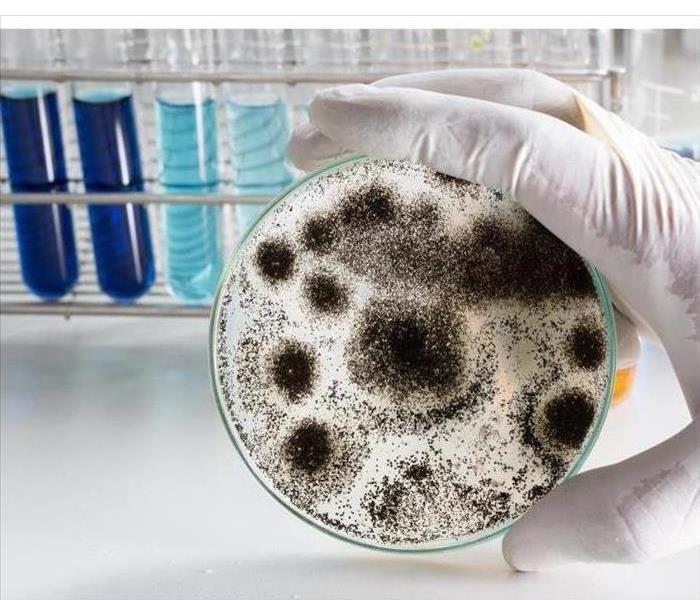 Mold sample taken for lab test
Mold sample taken for lab test
Hire an indoor environmental specialist to inspect any residence to which you are considering moving, as doing so could reveal costly complications before they become your debt to bear. Read on to learn how to pick one and what to expect once a professional has been selected.
What Indoor Environmental Testers Reveal
A comprehensive building examination can diagnose the presence of:
- Allergens
- Flammables
- Asbestos
- Radon
- Mold
Because of its prevalence and potential for rapid progression, the existence of mold is the most serious discovery an investigator can make. Before signing a lease, hire an expert to clear the home you wish to occupy.
How Indoor Environmental Testers Work
Beware that inspections conducted by an indoor environmental specialist average $400, although more extensive analyses run upwards of $1,000. Larger living quarters will result in heavier fees. Added services, such as testing for specific pollutants, will further increase your bill.
Qualified testers carry certifications acquired from officially approved associations. When interviewing inspectors, request documentation as proof. If doubts persist, contact the claimed institution directly for verification.
Experts remain significantly more accurate than any off-the-shelf mold test. Avoid the risk of accidental misdiagnosis by using a fungal renovation service to definitively determine the existence of mold growth. This is done by taking samples from exposed surfaces using swabs or tape. In certain instances, specially trained detection dogs may become necessary to pinpoint a problem’s origin.
When searching for other harmful substances, equipment such as air quality monitors, moisture meters, and thermal imaging cameras may be utilized. Inspections typically last up to three hours. Once the process is complete, you may have to wait between two and ten days to receive a detailed report.
Use an indoor environmental specialist to identify possible issues inhabiting a prospective dwelling located in or around Elmwood, RI. Though the initial cash outlay may seem unnecessary, the price will always remain preferential to the expense of extensive remediation.
6 Steps of Fire Damage Restoration
8/24/2022 (Permalink)
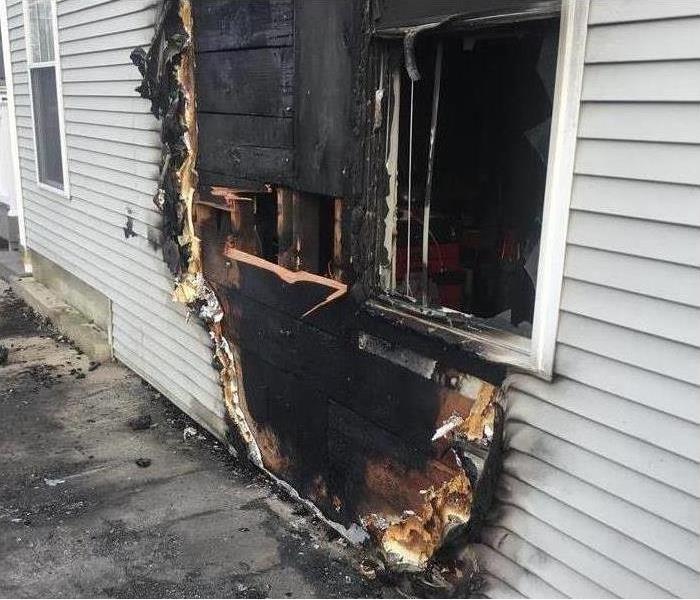 A house fire can be devastating.
A house fire can be devastating.
What Can You Expect During Professional Fire Restoration?
A house fire can be devastating enough, but what happens after firefighters extinguish the flames? There will be fire damage directly from the fire and the smoke, soot, extinguishing chemicals and water. The cleanup process must begin immediately to avoid additional loss.
1. Inspection
Once the flames are out, professionals will do a thorough inspection of all of the affected areas. The assessment tells them the extent of destruction and the best remediation method.
2. Content Removal and Cleaning
All damaged materials is removed from the home, including personal belongings, appliances and furniture. Fire remediation professionals can determine what is salvageable and what isn’t.
3. Structure Stabilization
A fire can cause significant damage to the roof and structural core of a home. Therefore, the structure needs board-up services and roof tarping to secure it from further loss (e.g., vandalism or weather).
4. Water Damage Restoration
Cleaning up water damage is a significant part of most fire restoration jobs. Unsalvageable water-soaked materials are then removed and thrown out. The cleanup professionals continue the drying process by extracting standing water and using industrial fans and dehumidifiers to dry the area. It needs to be dried as quickly as possible to avoid more damage such as mold growth and wood rot.
5. Cleaning and Disinfection
Powerful cleaning products remove soot from all surfaces. The professionals use ozone generators and other industrial equipment to remove smoke odor from all areas with smoke damage. The fire damage cleanup specialists then thoroughly clean and disinfect the entire home and the remaining contents.
6. Rebuilding
Finally, the final reconstruction begins returning the home to its original condition. Structural damage is rebuilt. Then, new drywall and flooring is installed.
If your home in Providence, RI, goes up in flames, the damage cleaning and fire restoration process will need to begin as soon as possible. Taking quick action helps avoid additional damage to the property.
How To Successfully Restore Wet Documents
7/31/2022 (Permalink)
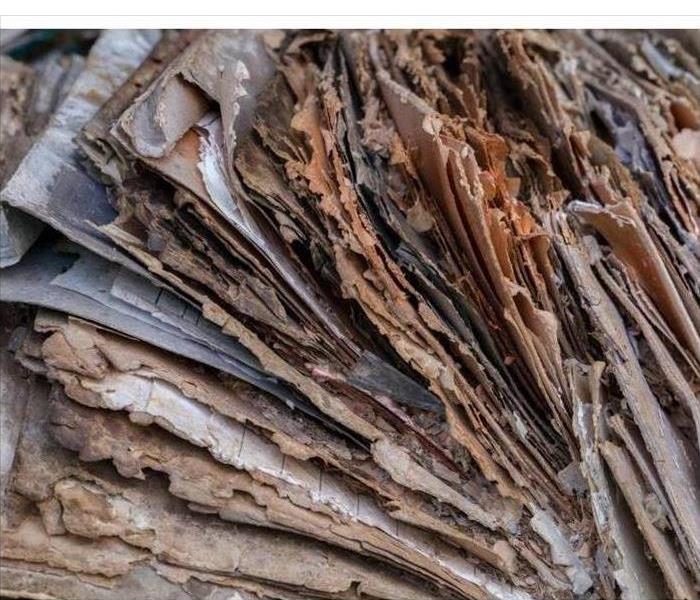 SERVPRO uses the latest in document drying technology
SERVPRO uses the latest in document drying technology
Losing important documents in a flood or fire can be devastating for your business in Elmwood, RI. You can rebuild the structure and replace the furniture, but what about irreplaceable papers and photographs? They may not be a total loss if the water restoration company you select has document restoration services available.
What Documents Can Be Restored?
Contracts, manuscripts, and other files
Books and magazines
Blueprints and maps
Photographs, films, and negatives
Finding an experienced technician as quickly as possible is the key to successful document restoration. Insurance companies choose SERVPRO more often than any other restoration service because of the advanced technology and knowledgeable professionals available all over the country. Each office is locally owned and operated, but has corporate resources available.
How Are the Documents Restored?
SERVPRO uses the latest in document drying technology. The vacuum freeze-drying technique is the same process used by the Library of Congress to dry historical papers and other valuable documents. In fact, this drying method is the only process that the National Archives and Records Administration (NARA) has approved for restoring wet documents.
Documents that have been exposed to flood water or sewage will likely contain harmful chemicals and bacteria. Technology using a gamma irradiation process will sterilize the documents so that they are safe to handle.
You can also rest assured that your sensitive documents will remain confidential. SERVPRO employs HIPAA-certified technicians, who are under constant supervision.
What About Digital Services?
There is no better time to have your important papers converted to digital format than before a disaster strikes. In a flood or fire, your records will be saved. You can also free up valuable storage space by keeping digital files.
The quicker you send out your irreplaceable documents for document restoration after a flood or other disaster, the faster you will be able to get your business back on track.
Does Your Business Need a Flood Cut?
7/23/2022 (Permalink)
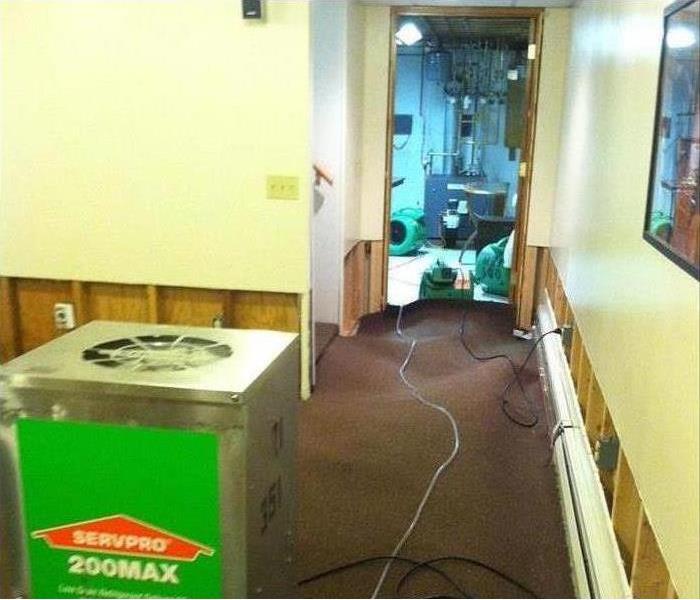 Flood cut in a Providence, RI business
Flood cut in a Providence, RI business
Flooding at your Providence, RI, business may require intensive restoration efforts in order to get back to pre-flood condition. In addition to drying out the area, replacing carpet and other remediation tasks, a flood cut may need to be made in order to fully address the water damage.
What Is A Flood Cut?
A flood cut is simply the removal of drywall approximately one foot above the visible waterline. This is done because water tends to wick upward through the wall.
When Are Flood Cuts Necessary?
Flood cuts are necessary in many situations, including the following:
- Gray water (mildly contaminated) floods
- Black water (heavily contaminated) floods
- Clean water floods that affect insulated walls
Gray and black waters require a flood cut because they are contaminated. The restoration company must tear out the drywall in the flooded area to ensure your business is safe and clean for you, your employees, and clients. Clean water floods, though not contaminated, still permanently damage insulation. Because the insulation cannot be dried, it must be removed to prevent mold growth.
Are There Any Alternatives to Flood Cuts?
When dealing with contaminated water or damaged insulation, a flood cut is the best way to prevent mold growth and further contamination. However, in the case of clean water flooding that does not affect any insulated walls, other drying options may be available. One such method is the use of regenerative blowers. Holes are drilled in the wall and hoses are inserted to allow dry air to flow freely.
How Soon Should a Flood Cut Be Made?
Flood damage should be addressed as soon as possible because moisture encourages mold growth. Even in cases of clean water and non-insulated drywall, it is still important to act quickly because clean water can become contaminated and turn into gray water within a day or two.
Regardless of the type of flooding your business experiences, a professional restoration team can take care of the water damage and any mold growth quickly and safely.
When Does Your Insurance Cover a Flood?
7/18/2022 (Permalink)
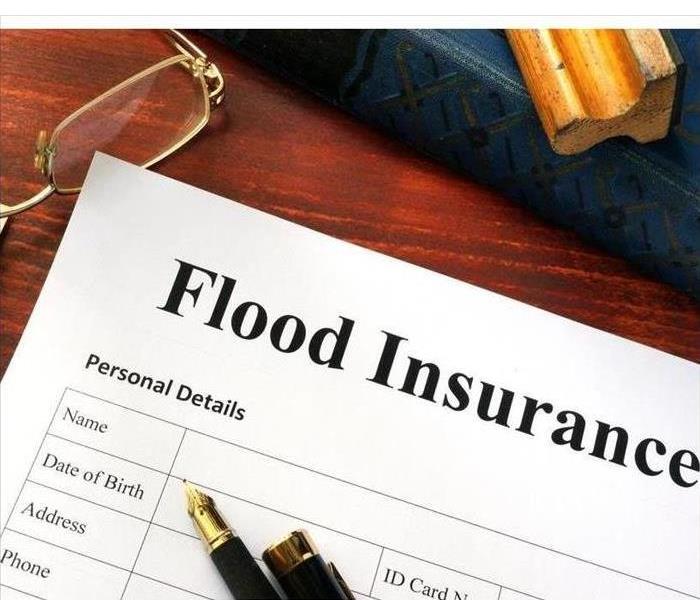 Consider purchasing flood insurance
Consider purchasing flood insurance
When Is a Flood Covered by Your Insurance?
Experiencing a disaster at home can be devastating. Flooding is one of the most common and damaging incidents that Elmwood, RI, homeowners encounter. There are some cases where your homeowner's insurance will cover the damage of a basement flood and other water damage. Other situations require that you turn to secondary flood insurance to file a claim.
What Your Homeowner's Insurance Covers
You purchase homeowner's insurance to help you when accidental damage occurs in your home and on your property. This applies to a flooded house as well. If there is sudden, unintentional water damage, your insurance should step in and help with repair and replacement costs. Some examples include:
- A broken pipe
- A failed appliance such as a dishwasher or water heater that expels water onto the floor or walls
- A leaky roof that lets rainwater into the attic
What Your Homeowner's Policy Doesn't Cover
Traditional insurance coverage won't take care of all your water damage. If you fail to properly maintain appliances and other systems in the home, the insurance company won't likely pay to repair the damage. If you intentionally cause flooding on your property, it will void any insurance protection, and you may face legal issues. Also, your policy won't cover the cause of the water damage, just the results. For instance, if your refrigerator breaks and leaks water down the wall, ruining the drywall, your insurance will pay to replace the wall but not the fridge.
When To Get Flood Insurance
You can get supplemental flood coverage to take care of water damage from issues such as sewer backups or main water line breaks. If you live in an area where a basement flood would be common because of severe storms or overflowing rivers or canals, you should consider purchasing flood insurance.
When you've got a basement flood or other damage, it's nice to know you can call a professional flood remediation team. You should also be prepared with adequate insurance to help cover the cleanup and replacement costs.
The Benefits of Claims Inventory Services
6/28/2022 (Permalink)
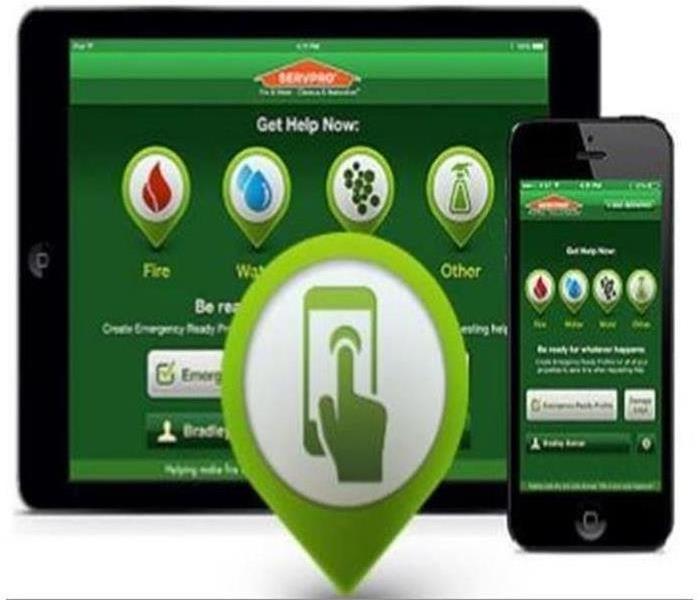 Clients can always view the updates on their online accounts.
Clients can always view the updates on their online accounts.
SERVPRO's Claims Inventory Service
When a commercial property is damaged by fire, flooding or mold, the expenses for mitigation and restoration can really add up. Business owners need a reliable way to keep track not only of structural elements that are compromised but also of items inside their buildings that need repair. SERVPRO's claims inventory service makes the process of filing an insurance claim for damaged property easier for your clients in Providence, RI.
Visual Proof of Damage
When SERVPRO technicians arrive at the building, they start with a thorough assessment of the damage to the structure. They may take several pictures of the affected area:
- Saturated drywall
- Collapsed ceiling tiles
- Damaged flooring
- Compromised items
This assessment gives business owners and their insurance providers a clear picture of the work that needs to be done. They can access the information at any time in order to file accurate claims.
Itemized List for Insurance Claim
Before any ruined building materials can be removed, the certified damage mitigation experts must take out furniture, equipment and other items that were in the path of destruction. Once these things are removed, they are inspected to see if they're salvageable.
An insurance agent may see a distinction between repair and replacement costs for the separate lists on the claim. Clients can always view the updates on their online accounts. Technicians update the report throughout the process to verify the work that has been completed or add new steps that have to be taken. Because the information is revised whenever there is a change, the itemized list serves as an accurate backup to the claim filed with the provider.
No matter why your clients need mitigation services, the claims inventory system helps them keep track of what's going on with their property. It makes filing an insurance claim as simple as possible.
How FEMA Can Help After a Flood
6/20/2022 (Permalink)
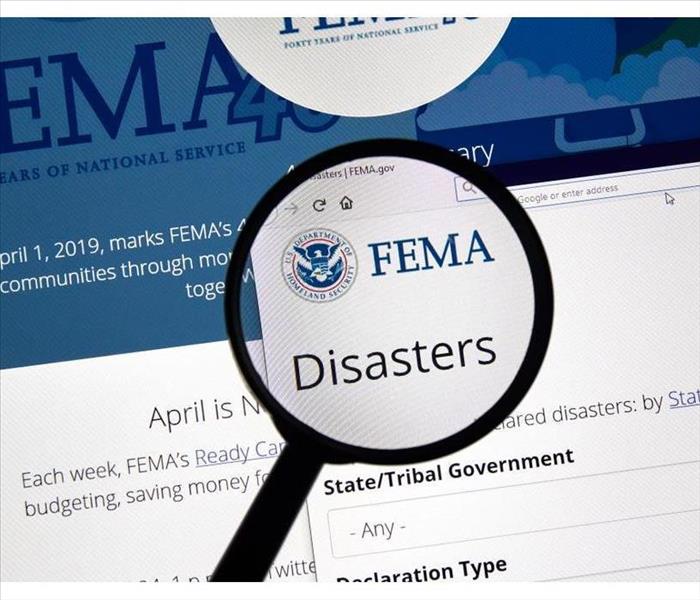 Organizations like FEMA are there to help with grants that may not cover everything but still make recovery easier.
Organizations like FEMA are there to help with grants that may not cover everything but still make recovery easier.
FEMA's Role in Flood Recovery
When a natural flood event happens in Elmwood, RI, even uninsured homeowners don’t have to weather the financial burden and recovery. A FEMA grant provides accepted households up to $36,000 for disaster relief. While this may not cover all the associated costs, it does provide relief. Before filing for a grant, it’s important to understand what the agency assists with.
Flooding Damage Relief
After an assessment of the damage is completed and a certified water damage restoration company has been secured to develop a restoration plan, you can expect the grant to help cover the costs for the following:
Roofs and Ceilings: If the storm wreaked havoc on the roof, these funds may be used to repair or replace affected materials.
Floors: While it may not cover replacement costs for new carpet or tiles, it will assist with any subfloor damage.
Windows: Broken windows related to the storm are included.
Property: The amount of property that is covered varies, but it may include the repair or replacement of HVAC systems, essential appliances and utilities.
Other Assistance
FEMA assistance comes in other forms besides ensuring your home is a safe and secure environment. Along with assisting with temporary relocation and related expenses, it may also help with child care and medical expense as well as replacing belongings, including:
- Clothing
- Job-required gear
- Educational tools
- Storage expenses
- Essential vehicle damage
- Disaster-related purchases
While these grants help with many different facets of the disaster, it’s also important to know that they will only be provided for up to 18 months. Typically, a household will receive around $5,000 a month to get their lives back on track.
Weathering a natural disaster comes with chaos and significant stress. While everything may seem hopeless, organizations like FEMA are there to help with grants that may not cover everything but still make recovery easier.
3 Ways the Pros Will Remove the Smoke Smell From Your Home
6/6/2022 (Permalink)
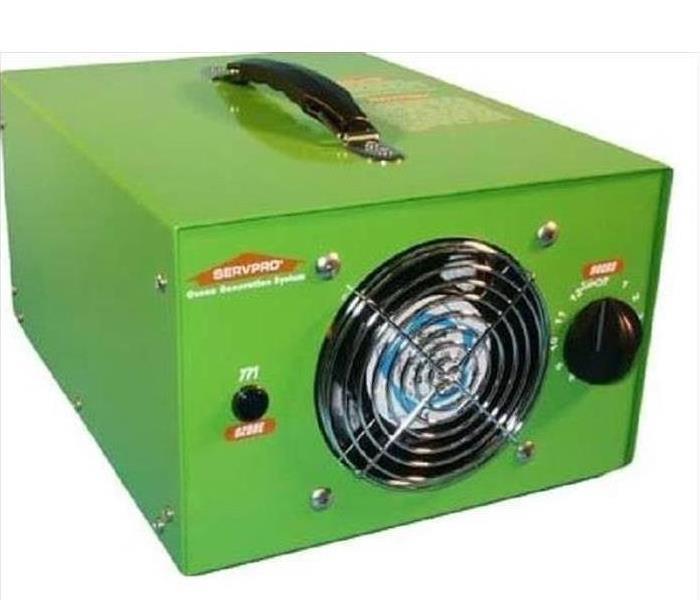 Ozone machines help to clean out the air.
Ozone machines help to clean out the air.
Three Ways To Remove Smoke Odor From Your Home
Even after the flame has been extinguished and the charred remains of your belongings have been removed, you'll notice that the smell of smoke lingers in your Providence, RI, home. Instead of using masking agents, such as air fresheners, to cover up the smell, the professionals cleaning your home will follow a strict protocol to keep the smell at bay. Here are three ways they will eliminate the smoke smell from your home.
1. Remove Smoke Damage Residue
The first step in smoke cleaning is to remove the damage. This damage includes items burned in the fire and soot and smoke left on the walls. The cleaners will use a special vacuum to ensure that all traces of soot are removed from all surfaces. They will then use a specialized cleaner to remove the soot off the walls, which helps keep the smell from returning.
2. Filter the Air
Even though you may not see it, there will be many soot and smoke particles in the air, which will cause the smoke odor to return over time if not treated properly. The odor removal professionals will use air filtration devices to clean and filter the air circulating throughout your home. If the smell remains after filtering the air, they will also use ozone machines to help clean the air, ensuring that the smoke cleaning process is successful.
3. Seal the Surfaces
As the final step of the cleaning process, the cleaners will seal the surfaces in your home damaged by smoke. The specialized sealing agent will prevent any smoke particles from seeping through and can be painted over so there won't be any evidence of the fire left.
Doing a thorough smoke cleaning can take some time and patience. However, when you trust the professionals to do it, you can rest assured knowing it's done correctly and that the smells won't return.
How To Prevent Mold Recurrence
5/26/2022 (Permalink)
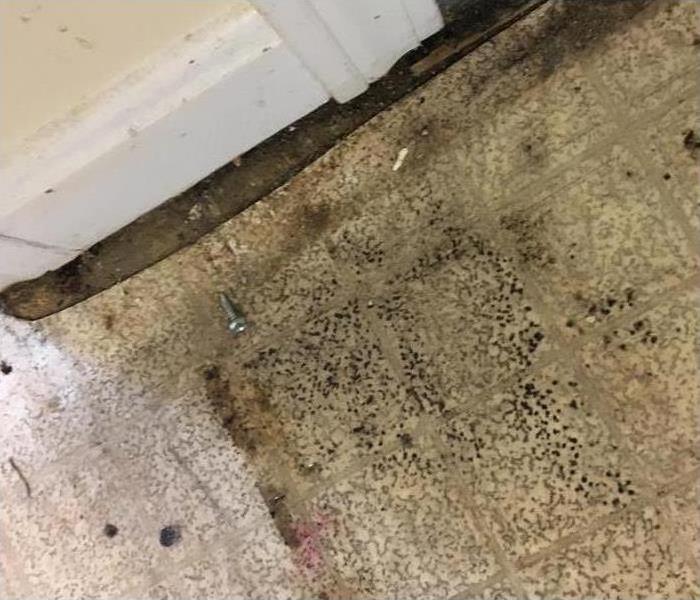 Mold growth after water damage in Elmwood, RI.
Mold growth after water damage in Elmwood, RI.
Mold Recurrence: How To Avoid It
Recurring mold growth in your Elmwood, RI, business is unwelcome and frustrating. Fortunately, knowing the causes for the recurrence will help you keep the problem at bay.
Necessary Conditions
Mold returns for the same reason that it occurs in the first place: The conditions are right. The following are three things that fungi need to thrive:
- Warmth
- Food source
- Water source
Most indoor locations are warm enough to support mold. Nutrient sources, including pulpy products, dust and dirt, are regularly found in most buildings as well. The presence of water, however, can generally be controlled.
Prevention Methods
Even if a professional restoration company performs the initial mold removal, it is still up to you, the business owner, to prevent future growth. As discussed above, the presence of water is generally the easiest condition to control. If the area with the recurring mold problem is prone to high humidity, install a dehumidifier to remove the moisture from the area. Address water damage as quickly as possible and dry up spills, leaks and all standing water immediately.
In addition to keeping the area as dry as possible, there are specialized products available that are resistant to mold growth. Common options include paints, primers and fabrics. There are also sprays that can be applied to certain surfaces that are thought to help repel mold.
Another option is minimizing the number of mold spores present in the area. These spores occur almost everywhere, so it can be helpful to trap them in a HEPA filter before they have a chance to colonize. You may even have a chance to address two factors with one product if you select a combination dehumidifier and purifier.
Ideally, mold that has been properly removed would not return. However, this is not always the case. Fortunately, there are a variety of tactics available to those who are struggling with recurring mold growth.
How To Prepare for a Business Fire
5/21/2022 (Permalink)
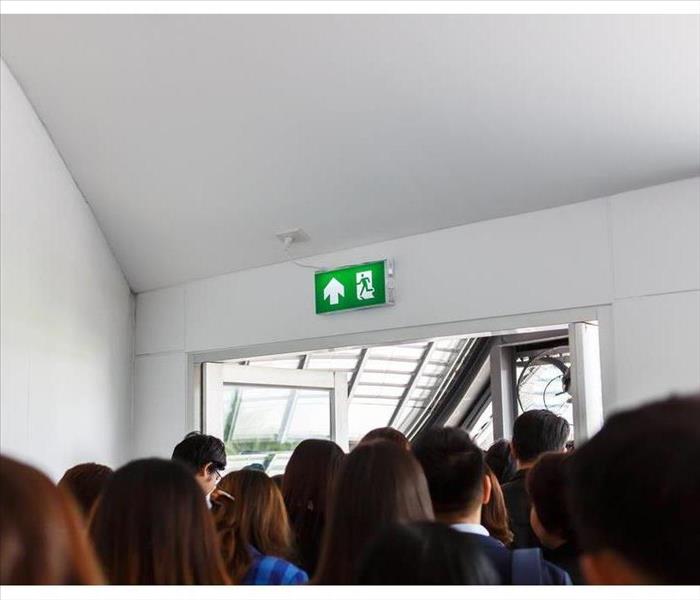 Employees should be trained in how to exit the building in the case of a business fire.
Employees should be trained in how to exit the building in the case of a business fire.
Steps In Fire Preparation
Commercial fires can damage a company’s building, but businesses in Providence, RI, can prepare for a business fire by planning ahead. Taking these four steps in fire preparation allows businesses to minimize risk and fire damage in the case of an emergency.
1. Establishing a Fire Safety Plan
Employees should be trained in how to exit the building in the case of a business fire. Local fire marshals or the building’s property manager can help determine the best escape route. Additionally, the business can compile a list of emergency contact numbers, including first responders, important clientele and a fire restoration company.
2. Installing Proper Equipment
Fire codes typically require businesses to install a sprinkler system and smoke detectors, as well as have one fire extinguisher per floor of the company’s building. However, businesses should consider having more fire extinguishers available, as they are the best tool for employees to put out small fires. Companies should regularly test the batteries in the smoke detectors and invest in fire blankets and first aid kits.
3. Conducting Appropriate Training
Employees need to be trained in how to use any fire safety equipment. Businesses can instruct workers on how to properly operate fire extinguishers and administer first aid. Routinely conducting fire drills will also ensure employees know how to execute the safety plan.
4. Determining a Fire Damage Recovery Plan
If a commercial fire occurs, having a plan for restoring operations assists the company in returning to work as soon as possible. Once the property has been deemed safe, employees can recover items from the premises and begin the process of fire restoration with the help of trained professionals.
Taking the proper steps to prepare for a business fire helps companies navigate the dangers efficiently and safely. Knowing what to do in the case of an emergency ensures a business survives a fire and can continue to serve customers after the incident.
3 Reasons Black Water in Your Home Is an Emergency
5/16/2022 (Permalink)
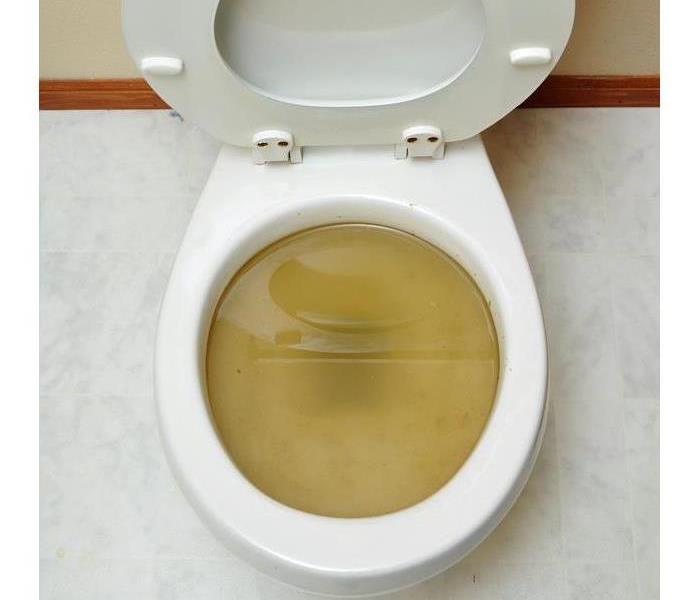 A flooded toilet can spread throughout the home.
A flooded toilet can spread throughout the home.
Three Reasons Why Black Water in Your Home Is a Disaster
While unwanted water in your home in Elmwood, RI, is a big problem, the situation becomes much worse if the water is contaminated. This could be the result of floodwaters coming into your home, or it could be from a ruptured pipe that carries sewage. At this point, you will need a professional sewer cleanup. Several important factors label this as an emergency.
1. A Sewer Backup Poses a Risk to Everyone
Dirty water in your home puts everyone in the household at risk. Any surfaces that water came in contact with could be contaminated. Sometimes that damage cannot be seen, but it is there nonetheless, resulting in unsanitary conditions. The best bet is to call a local water damage restoration company. Trained technicians will arrive in a matter of hours and focus on safety right away.
2. A Flooded Toilet Can Spread Throughout the Home
Water does not tend to stay in one place but can seep into floors and even drip into the room below the initial spill. A professional sewer cleanup will work to contain the contaminated water, thus limiting the scope of the property damage. With the right equipment for the job, such as water vacuums and powerful pumps, a trained crew ensures the water does not spread into other areas.
3. A Water Spill Gets Worse Over Time
As a powerful corrosive agent, water, especially black water, can eat away at nearly all the elements of a home. This includes breaking down wooden structures and even having an impact on metals, ceramics and other durable materials. A rapid cleanup doesn't give water a chance to work on vulnerable materials. It also is less likely to result in mold growth from saturated surfaces and elevated humidity levels.
A sewer cleanup is a job for professionals who will arrive quickly. It requires a rapid response to limit the damage caused by black water.
How to Prepare Your Commercial Property for a Winter Storm
4/26/2022 (Permalink)
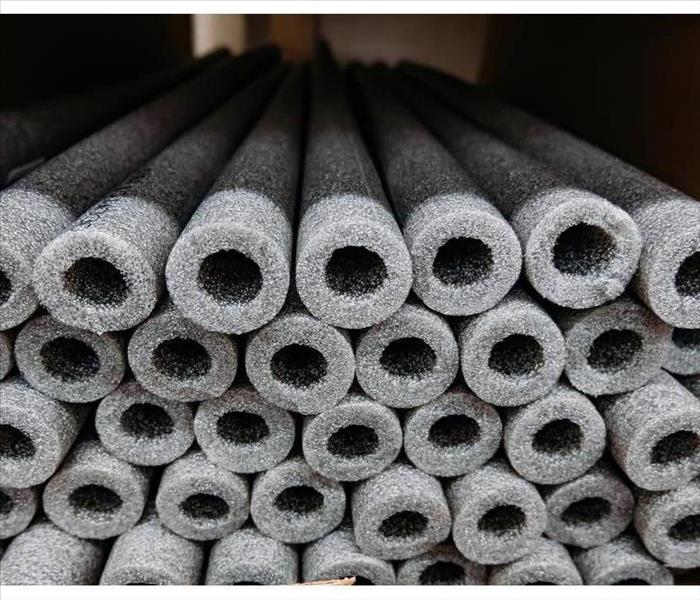 To prevent a pipe break, insulate around your pipes to keep the cold air out.
To prevent a pipe break, insulate around your pipes to keep the cold air out.
Keep Your Commercial Property Safe From a Storm
A winter storm could cause devastating damage to commercial buildings in Providence, RI. Freezing temperatures affect the construction materials of buildings by corroding, expanding, and tearing them. Materials that are affected by below-freezing temperatures include:
- Pipes
- Windows
- Roofs
- HVAC units
You can keep your property safe from bad weather by maintaining and updating your building as needed. Here are a few things you can do to keep your commercial property safe from a storm.
1. Maintain Your HVAC System
An HVAC unit has the power to heat your building and keep colder temperatures out. You will need to crank up the heat when temperatures drop. To keep your system maintained and functional before a winter storm, change the filters regularly and have the unit professionally cleaned at least once a year.
2. Check That Your Windows Are Properly Sealed
In older buildings, the sealant around windows becomes corroded with time. Make sure your windows are sealed well enough to keep out unwanted moisture. This prevents storm damage from ice and higher humidity levels in the building. It can also save you money on your electrical bill and ensures the HVAC system is not working harder than it needs to.
3. Insulate Around Your Plumbing
One of the main reasons insurance companies receive calls in the aftermath of inclement weather is damage from burst or broken pipes. A burst pipe occurs when water freezes inside of the plumbing, causing the pressure to increase and pipes to burst. To prevent a pipe break, insulate around your pipes to keep the cold air out. Remember to allow warm air to circulate around indoor water supply lines by opening cabinet doors. Any outdoor pipes should also be well insulated.
Prevent unwanted damage by keeping your property well maintained year-round. If you have experienced a burst pipe from a winter storm, contact a storm damage restoration service to aid in cleanup and repairs.
 Mold can grow in your home or workplace, call a professional mold remediation company for proper cleanup.
Mold can grow in your home or workplace, call a professional mold remediation company for proper cleanup.






 24/7 Emergency Service
24/7 Emergency Service



















